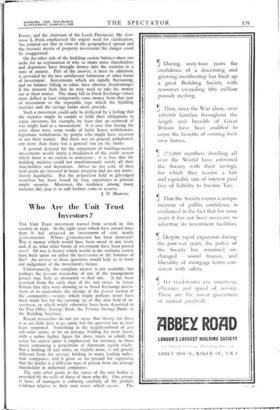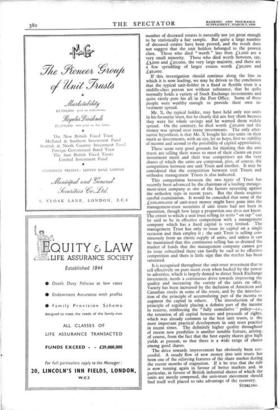Who Are the Unit Trust Investors ?
THE Unit Trust movement started from scratch in this country in 1931. In the eight years which have passed since then it has attracted an investment of very nearly Lioo,000,000. Whose Lioo,000,000 has been attracted? Was it money which would have been saved in any event and, if so, what other forms of investment have been passed over? Or was it money which would in the ordinary course have been spent on either the necessaries or the luxuries of life? An answer to those questions would help us to form our judgement of the movement's future.
Unfortunately, the complete answer is not available, but perhaps the present researches of one of the management groups may help us ultimately to find one. It has been assumed from the early days of the unit trusts in Great Britain that they were drawing in to Stock Exchange invest- ment or its equivalent, the savings of the poorer section of the community—savings which might perhaps never have been made but for the opening up of this new field of in- vestment, or which might otherwise have been deposited in the Post Office Savings Bank, the Trustee Savings Banks or the Building Societies.
Recent researches do not yet upset that theory, for there is as yet little data to go upon, but the question has at least been reopened. Something in the neighbourhood of 200 sub-units seems to be an average holding for most trusts, with a rather higher figure for those trusts in which the scope for capital gains is emphasised, for instance, in those trusts containing a proportion of American equity stocks. But a holding of 200 units, or slightly more, is not greatly different from the average holding in many leading indus- trial companies, and it gives us no ground for supposing that the holder is a different type of person from the average shareholder in industrial companies.
The only other guide to the status of the unit holder is provided by the wills of those of them who die. One group, at least, of managers is collating carefully all the probate evidence relative to their own trusts which occurs. The number of deceased estates is naturally not yet great enough to be statistically a fair sample. But quite a large number of deceased estates have been proved, and the result does not suggest that the unit holders belonged to the poorest class. Those who died " worth " less than £I,000 are a very small minority. Those who died worth between, say, £3,000 and £20,000, the very large majority, and there are a few sprinkling of larger estates worth £30,000 and £40,000.
If this investigation should continue along the line in which it is now leading, we may be driven to the conclusion that the typical unit-holder in a fixed or flexible trust is a middle-class person not without substance, that he quite normally holds a variety of Stock Exchange investments and quite rarely puts his all in the Post Office. Some of these people were wealthy enough to provide their own in- vestment spread.
Mr. X, the typical holder, may have held only 200 units in his favourite trust, but he clearly did not buy them because they were his whole savings and he wanted them widely spread. On the contrary, he died worth £20,000 and the money was spread over many investments. The only alter- native hypothesis is that Mr. X bought his 200 units on their merit as investments, with an eye, let us hope, first to stability of income and second to the possibility of capital appreciation. These seem very good grounds for thinking that the unit trusts are selling their wares to most of their clients on pure investment merit and their true competitors are the very shares of which the units are composed, plus, of course, the competition between one unit Trust and another. It may be considered that the competition between unit Trusts and orthodox management Trusts is also indicated.
This competition between the two types of Trust has recently been advanced by the chairman of a leading manage- ment-trust company as one of the factors operating against the orthodox type in recent years. But the thesis requires careful examination. It would be conceded that some of the Lioo,000,000 of unit-trust money might have gone into the management-trust securities if unit trusts had not been in operation, though how large a proportion one does not know.
The extent to which a unit trust selling its units " on tap " can be said to be in effective competition with a management company which has a fixed capital is very limited. The management Trust has only to issue its capital on a single occasion and then employ it ; the unit Trust is selling con- tinuously from an elastic supply of units, and unless it can be maintained that this continuous selling has so drained the market of funds that the management company cannot get its issue subscribed there can hardly be said to be effective competition and there is little sign that the market has been saturated.
It is recognised throughout the unit-trust movement that to sell effectively on pure merit even when backed by the power to advertise, which is largely denied to direct Stock Exchange investment, needs a continuous drive towards improving the quality and increasing the variety of the units on offer. Variety has been increased by the inclusion of American and Canadian stocks in some of the trusts, and by the introduc- . tion of the principle of accumulating part of the income to augment the capital in others. The introduction of the principle of regularly placing a definite part of the income to reserve, reinforcing the " fully cumulative .' policy—i.e., the retention of all capital bonuses and proceeds of rights, which was already common to the best unit trusts, is the most important practical development in unit trust practice in recent times. The definitely higher quality throughout of recent new portfolios is another notable feature, arising, of course, from the fact that the best equity shares give high yields at present, so that there is a wide range of choice among good shares.
The drive towards improvement has obviously been suc- cessful. A steady flow of new money into unit trusts has been one of the relieving features of the share market during the recent months of stagnation. If it be true that the tide is now turning again in favour of better markets and, in particular, in favour of British industrial shares of which the units are mostly composed, the unit-trust movement should find itself well placed to take advantage of the recovery.
STERLING_



























































 Previous page
Previous page